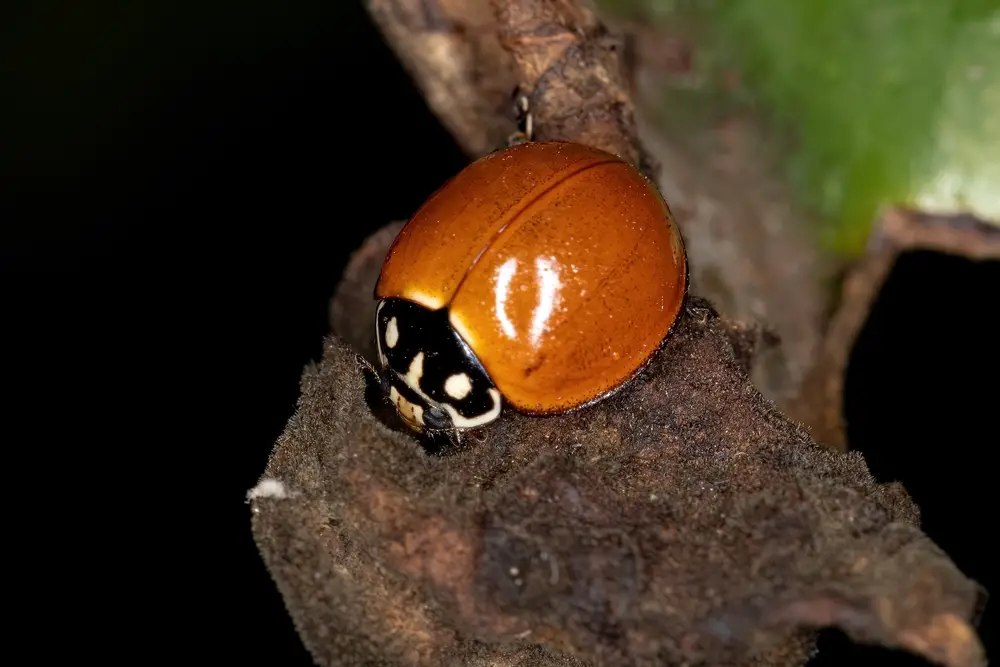
Ladybugs, with their bright red shells and contrasting spots, are a familiar sight in gardens and on windowsills. You might wonder if these apparently gentle insects are equipped with teeth, especially when they land on your hand. Contrary to common belief, ladybugs don’t have teeth as you would typically understand them. Instead, they possess powerful mandibles that are more akin to pincers, designed to grasp and crush their prey.
Although it’s unusual, ladybugs can bite humans using these mandibles. Such bites might be surprising, but they’re generally harmless and rarely break the skin. Some species, like the Asian lady beetle, are more prone to biting than the native varieties you’re used to seeing. If you’re dealing with ladybugs in your home, it’s also interesting to learn about ladybug infestations and how to manage them without harm.
An inquisitive observation might reveal ladybugs hard at work in your garden, munching on aphids and other soft-bodied pests. This behavior showcases how beneficial they are to gardening enthusiasts. Despite their lack of true teeth, ladybugs are proficient predators, keeping the populations of harmful insects in check, making the small beetles welcome in gardens for their pest control abilities.
Ladybug Anatomy
In exploring ladybug anatomy, you’ll find they possess the basic insect structure along with unique features suited to their lifestyle.
Mouthparts and Feeding Mechanism
Your curiosity about whether ladybugs have teeth can be addressed by understanding their mouthparts. Ladybugs have adapted a pair of chewy appendages called mandibles. These mandibles act like pincers, enabling ladybugs to grasp and macerate their prey. Contrary to having teeth as mammals do, a ladybug’s mandibles are effective for their dietary needs, allowing them to feed on soft-bodied insects like aphids. For a closer look at their eating habits and biological design, you might be interested to learn that ladybugs chew with the help of mandibles and palps, which form the core components of their feeding mechanism.
Dietary Habits of Ladybugs
Ladybugs are fascinating little creatures, and your garden will love them for their dietary habits. These insects, belonging to the family Coccinellidae, don’t have teeth like mammals do; instead, they possess mandibles which they use to grasp, crush, and chew their prey, primarily soft-bodied insects.
Here’s a quick rundown of what they typically feast on:
- Aphids
These pests are ladybugs’ favorite menu item, helping to control them in your garden naturally. - Mites and Scale Insects
Ladybugs assist in keeping the population of these pests in check.
You might be curious to learn ladybugs exhibit an interesting feeding behavior known as Acariphagous, which means they feed on mites. Additionally, the term Coccidophagous describes their appetite for scale insects, another common garden pest.
Your home or garden might be a buffet for them because of their varied diet. They also adapt their diet based on availability, which can include:
- Insect eggs
- Small larvae
- Nectar
- Pollen
This varied diet makes them an essential ally in the management of pests, sustaining the health of your plants. Remember, ladybugs are the helpful guests that don’t mind the menu, as long as it includes their insect favorites!
Comparative Anatomy
When you look across the insect world, you’ll find fascinating variations in mouthparts adapted to different diets. Let’s explore how this relates to ladybugs.
Insect Dentition Differences
Unlike mammals, ladybugs, part of the insect family known as Coccinellidae, don’t have teeth akin to what you might be imagining. Their mouthparts are specially adapted for their diet and lifestyles. Instead of teeth, ladybugs have mandibles that are designed to grasp, crush, or cut their food. These mandibles act like pincers, allowing ladybugs to consume various prey, primarily aphids, which are a main food source for them.
Insects vary greatly in their oral structures, depending on their dietary needs. For example, some insects like butterflies have a proboscis, which they use like a straw to drink nectar. Comparatively, ladybugs have a chewing mouthpart structure enabling them to eat other insects.
The mandibles of a ladybug are powerful for their size and enable the ladybug to eat other soft-bodied insects effectively. Your typical visualization of teeth, such as those found in vertebrates, doesn’t apply to ladybugs or other insects, which evolved differently to suit their environmental niche.
Remember, the next time you see a ladybug, their charming spotted exterior houses a pair of robust mandibles, a testament to the diverse adaptations in insect anatomy.
Frequently Asked Questions
When exploring the habits and characteristics of ladybugs, you might have some common inquiries regarding their interaction with humans. This section aims to address those specific questions clearly and concisely.
Do ladybugs bite humans?
Yes, ladybugs can bite. Their bites feel like a light pinch and are not usually painful or harmful. For more details, visit Ladybug Bites.
Are ladybugs capable of causing harm to people?
Ladybugs are generally not harmful to people. They don’t carry diseases, and their bites rarely cause any significant issues. However, some people might experience an allergic reaction.
Are there any toxins present in ladybugs?
No, ladybugs are not poisonous to humans. But they can produce a yellow fluid that is bitter tasting and may stain surfaces.
What are the typical symptoms following a ladybug bite?
Common symptoms following a bite might include a small red mark or minor swelling. This is due to the ladybug’s bite rather than the release of any venom or toxin.
What is the appearance of a ladybug bite?
A ladybug bite may cause a tiny red bump on the skin, similar in appearance to a mosquito bite.
Is there pain associated with a ladybug bite?
Typically, a ladybug bite does not cause significant pain. If you are bitten, you might feel a slight pinch or discomfort, but nothing intense or lasting.
Driven by a passion for those tiny creatures that rule our world, we at Bug Domain strive to be your go-to resource for information on insects.




